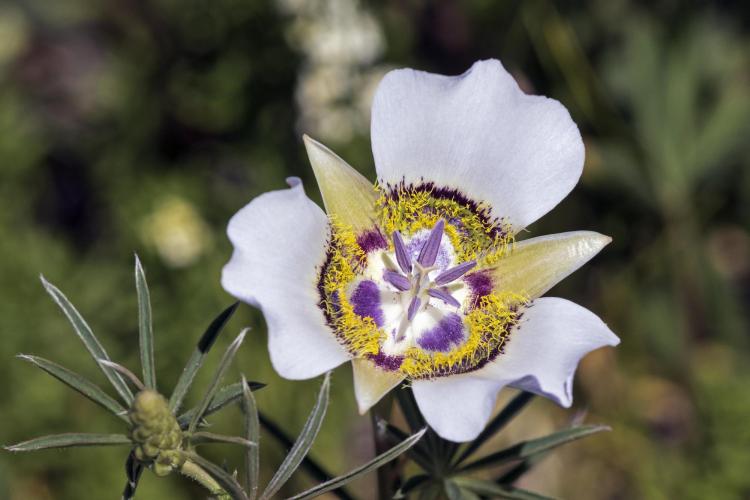Western sego lilies reach mountain meadows to hot deserts
Colorful cup-shaped flowers likely to bloom in force after wet winter
Approximately 60 species of sego lilies, also called mariposa lilies, are found in western North America and three are native to Colorado. Our natives are superficially similar, for each has a single, grass-like basal leaf plus a few small, linear leaves on stems and anywhere from one to a few stems supporting large, colorful, cup-shaped flowers. Each flower is comprised of three petals, each with a large gland that produces nectar, three sepals, six anthers and a stigma with three lobes.

Gunnison's sego lily from Cement Creek, near Crested Butte. Photo by Jeff Mitton.
Our local species are readily identified by their different but overlapping elevational ranges, flower colors and patterns, hairs on petals and stem characteristics.
Sego and mariposa are two terms used to refer to all of the lilies in this group. "Mariposa" is a Spanish word for "butterfly," referring to its most colorful pollinators. "Sego" is a Shoshone word, meaning "edible bulb," referring to the root organ that the Native American tribe considered a delicacy. Gunnison's sego lily is named after explorer Capt. John Williams Gunnison, who died in a conflict with Native Americans when he was serving as leader of an expedition to find a railroad route in Colorado — perhaps through the Black Canyon of the Gunnison. Nuttall's sego lily is named after a famous botanist who first described this species.
Gunnison's sego lily, Calochortus gunnisoni, has the highest elevational range, as it can thrive from mesas at the lower edge of the ponderosa pine belt to high mountain meadows. It is the only sego lily in Boulder County, but its native range stretches from southern Arizona and New Mexico to Montana. It is distinguished from the other Colorado sego lilies by a broad, dense band of yellow hairs encircling the inner portion of the floral cup, immediately above the nectaries — the other species lack this continuous band of hairs. Gunnison's petal colors are commonly white, but can have accents of blue or pink.
Nuttall's sego lily, C. nuttallii, has an intermediate elevational range that overlaps with the higher Gunnison's lily and lower winding sego lilies. This sego occupies communities dominated by sagebrush or pinyon pine or ponderosa pine. Nuttall's geographic range is the most extensive, stretching from Mexico to Canada but also reaching east to Nebraska and west to Nevada and Idaho. Nuttall's distinguishing characteristic is a pair of conspicuous, broken bands of burgundy above each nectary — neither band reaches either edge of the petal.
Gunnison's sego has a ring of burgundy above the band of yellow hairs, but this band is complete, reaching both edges of each petal to form a continuous circle. Petal colors of Nuttall's sego lily, aside from burgundy bands, are most commonly white but can be cream or lavender.
Winding sego lilies, C. flexuosus, have the lowest elevational range, from portions of the Mohave, Sonoran Desert and Great Basin Deserts to pinyon-juniper woodlands in Colorado and Utah. I have found winding sego lilies on the rim of Ruby Canyon, near the point where the Colorado River crosses the border between Colorado and Utah. Winding sego lilies have the smallest range, reaching from California to western New Mexico and Colorado, but not reaching into the northern portions of Colorado, Utah or Nevada.
Winding sego lilies are distinguished from the other sego lilies by stems that wind and spin as they grow. They have sparse hairs above the nectaries that do not form a broad continuous band, as in C. gunnisoni, and they lack burgundy bands on the petals. Their corollas have yellow bases, sometimes with orange spots, turning to lavender in the mid- to upper-portions of the petals.
Shortly after the first white settlers arrived in Utah, an epidemic of crickets devoured their crops, leaving the settlers facing starvation. Native Americans, keenly aware that sego lilies had edible bulbs, showed the settlers how to find and harvest the bulbs. To acknowledge the importance of the sego lily to the settlers, Nuttall's sego was proclaimed the state flower.
I remember driving into Utah on I70 in May, after a wet winter, and noticing bright colors on the rolling hills beneath the Book Cliffs — sego lilies. At Sego Canyon, north of Thompson Springs, the blooms seemed to pour out of the canyon onto the hills and badlands. Given that precipitation was well above average this winter, and given the remarkable blooms of flowers in southern California, I am predicting an exuberant display of sego lilies below the Book Cliffs in May.

